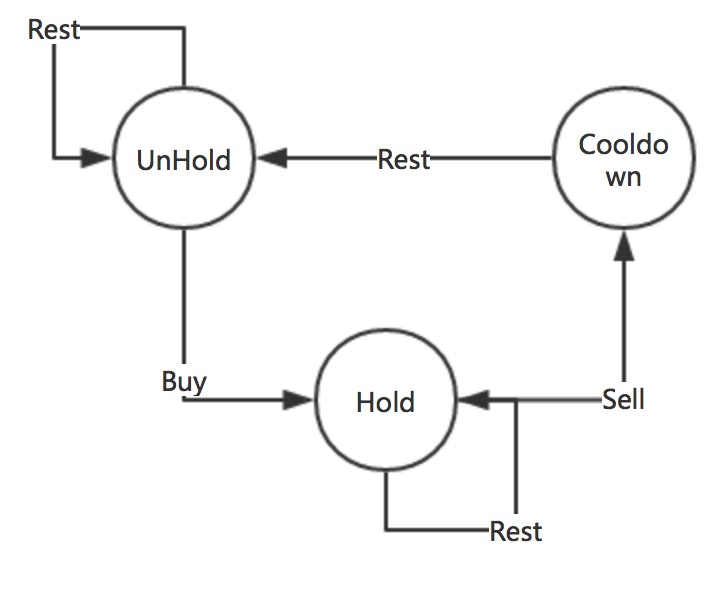动态规划中五道股票买卖题目详解
本文从属于笔者的 数据结构与算法 系列文章中的 动态规划 部分,同时也归纳于笔者的 我的校招准备之路:从Web前端到服务端应用架构 这篇综述。
Leetcode上有五道关于股票买卖相关的问题,恰巧笔者面试阿里的时候也被问及,因此在本文中略作总结,这五个问题列举如下:

简单买卖:只允许买卖一次
本题意思就是你得到一系列在接下来几天的股票价格,现在你被允许只用一次交易(就是买进再卖出)来获取最大利益。 这个很简单,只要用双指针的方法记住获利的大小,再筛选出最大的即可。 代码 如下:
/**
* @function 仅允许买卖一次
* @description Say you have an array for which the ith element is the price of a given stock on day i.If you were only permitted to complete at most one transaction (ie, buy one and sell one share of the stock), design an algorithm to find the maximum profit.
* @OJ https://leetcode.com/problems/best-time-to-buy-and-sell-stock/
*/
public class Stock1 {
public int maxProfit(int[] prices) {
//存储最大值的变量,初始化为0
int ans = 0;
//判断是否有效价格序列
if (prices.length == 0) {
return ans;
}
//判断应该在哪一日买入,即最小值
int bought = prices[0];
//遍历所有交易日价格
for (int i = 1; i < prices.length; i++) {
//判断本日是否能够卖出
if (prices[i] > bought) {
//判断如果本日卖出收益是否最大
if (ans < (prices[i] - bought)) {
ans = prices[i] - bought;
}
} else {
//判断本日是否为最低价格
bought = prices[i];
}
}
return ans;
}
}
简单买卖:可以买卖无穷多次
意思是买卖股票时可以不计买卖次数,但是必须在买之前先把以前的股票卖掉。然后求能获利最大的额度。 这样的话也很简单,只要遇见下一天的价格比这一天价格高的话,就卖出。 代码 如下:
package wx.algorithm.op.dp.stock;
/**
* Created by apple on 16/8/21.
*/
/**
* @function 能够进行无穷多次买卖, 求取最大值
* @OJ https://github.com/wxyyxc1992/just-coder-handbook/blob/master/Algorithm/java/src/main/java/wx/algorithm/op/dp/stock/Stock2.java
*/
public class Stock2 {
public int maxProfit(int[] prices) {
int total = 0;
//遍历所有交易日
for (int i = 0; i < prices.length - 1; i++) {
//只要是后一天比前一天贵,就卖出
if (prices[i + 1] > prices[i]) total += prices[i + 1] - prices[i];
}
return total;
}
}
最多买卖两次
现在你被允许买卖的次数减少到最多交易两次,也是必须先卖出再买进。然后求能获利的最大额度。
我们来琢磨一下这个规则,每次交易必须先卖掉手上这只股票才能进行下次操作,比如下面几天的股票价格为【1,7,15,6,57,32,76】,买第一只股票价格为¥1,为了最大获利,在¥76时卖掉肯定最好,由于交易时必须先卖再买,所以要是这么交易的话,只能交易一次。但是现在我们有两次买卖机会,也
许在这几天中,中间两次的交易就的获利总和就能超过¥76-¥1=¥75,所以我们要来找到这个组合。既然交易不能交叉(must sell the stock before you buy again),也就是说我们在遍历价格差找最大获益时,可以首位同时进行。可以用双向动态规划的思想来做。 代码 如下
package wx.algorithm.op.dp.stock;
/**
* Created by apple on 16/8/21.
*/
/**
* @function 最多两次买卖
* @OJ https://leetcode.com/problems/best-time-to-buy-and-sell-stock-iii/
*/
public class Stock3 {
public static int maxProfit(int[] prices) {
//判断是否为有效交易天数
if (prices.length == 0) return 0;
//存放左半部分最大收益
int[] left = new int[prices.length];
//存放右半部分最大收益
int[] right = new int[prices.length];
//初始化为0
int leftMin = prices[0];
int rightMax = prices[prices.length - 1];
//总收益
int sum = 0;
//计算左半段最大收益
for (int i = 1; i < prices.length; i++) {
//获取左半部分的最低价
leftMin = Math.min(prices[i], leftMin);
//获取左半部分最大收益
left[i] = Math.max(prices[i] - leftMin, left[i - 1]);
}
//计算右半段最大收益
for (int i = prices.length - 2; i >= 0; i--) {
//获取右半部分最低价
rightMax = Math.max(prices[i], rightMax);
//获取右半部分最大收益
right[i] = Math.max(rightMax - prices[i], right[i + 1]);
}
//找出两次交易最大收益组合
for (int i = 0; i < prices.length; i++) {
if ((left[i] + right[i]) > sum) sum = left[i] + right[i];
}
return sum;
}
public static void main(String args[]) {
int[] prices = new int[]{1, 7, 15, 6, 57, 32, 76};
System.out.print("maxProfit is" + maxProfit(prices));
}
}
在上面left和right的计算当中,left存储的获利为【¥0,¥6,¥14,¥14,¥56,¥56,¥75】,right存储的获利为【¥75,¥70,¥70,¥70,¥44,¥44,¥0】,可以看出买入第一次股票,在最后一天卖出股票获利是做多的是¥75,但是由于可以交易两次,我们可以看出在¥1时买入,¥57时卖出,再在¥32时买入,在¥76卖出,获利是最多的,一共是¥100.
最多买卖K次
此情况下允许用户买卖多次,以期获取最大值。最方便想到的办法会是回溯,不过不可避免的会导致重复计算,因此最好的还是进行动态规划。当我们考虑如何构建动态规划的状态转换函数时,首先假想下我们构建的状态转移表,应该会包含k,即我们的交易次数与i,即交易天数这两个变量。不过本题中存在的问题是每个i同时还存在三个状态,即i天买入或者卖出或者啥都不做,抽象成两个状态的就是第i天是持有股票还是不持有股票。我们可以为此建立两个向量:
-
holdi: 对于0~i天中最多进行j次交易并且第i天仍然持有股票的收益
-
unholdi: 对于0~i天中最多进行j次交易并且第i天不持有股票的收益
第i天持有股票的收益为 之前买了股票但还没有卖出 或者 今天才选择买入股票 二者中较大值
-
holdi = Math.max(unholdi-1-prices[i],holdi-1);
第i天不持有股票的收益为 选择今天卖出 或者 今天不买入时 最大的收益
-
unholdi = Math.max(holdi-1+prices[i],unholdi-1);
代码 如下
package wx.algorithm.op.dp.stock;
/**
* Created by apple on 16/8/21.
*/
public class Stock4 {
/**
* @param k 可交易的次数
* @param prices 价格向量
* @return
* @function 计算最多K次情况下能获得的最大理论
*/
public int maxProfit(int k, int[] prices) {
if (k == 0 || prices.length < 2)
return 0;
if (k > prices.length / 2)
return noLimit(prices);
// hold[i][j]: 对于0~i天中最多进行j次交易并且第i天仍然持有股票的收益
// unhold[i][j]: 对于0~i天中最多进行j次交易并且第i天不持有股票的收益
// 第i天持有股票的收益为 之前买了股票但还没有卖出 或者 今天才选择买入股票 二者中较大值
// hold[i][j] = Math.max(unhold[i-1][j]-prices[i],hold[i-1][j]);
// 第i天不持有股票的收益为 选择今天卖出 或者 今天不买入时 最大的收益
// unhold[i][j] = Math.max(hold[i-1][j-1]+prices[i],unhold[i-1][j]);
int[][] hold = new int[k + 1][prices.length];
int[][] unhold = new int[k + 1][prices.length];
for (int i = 1; i <= k; i++) {
//初始化持有状态下的初始值
hold[i][0] = -prices[0];
//初始化不持有状态下的初始值 为0
unhold[i][0] = 0;
for (int j = 1; j < prices.length; j++) {
hold[i][j] = Math.max(-prices[j] + unhold[i - 1][j], hold[i][j - 1]); // Buy or not buy
unhold[i][j] = Math.max(prices[j] + hold[i][j - 1], unhold[i][j - 1]); // Sell or not sell
}
}
//真实情况下最后一天了还是要卖出的
return unhold[k][prices.length - 1];
}
private int noLimit(int[] prices) { // Solution from Best Time to Buy and Sell Stock II
int max = 0;
for (int i = 0; i < prices.length - 1; i++) {
if (prices[i + 1] > prices[i])
max += prices[i + 1] - prices[i];
}
return max;
}
}
T+2规则
本题意为用户在卖出之后需要休息一天才能进行操作,那么在本题中用户是存在有三个状态,未持有(unhold)、持有(hold)、休息(cooldown)这三种,这三种状态的状态转化图为:

其对应的状态转换函数为:
unhold[i] = max(unhold[i - 1], cooldown[i - 1]); // Stay at s0, or rest from s2 hold[i] = max(hold[i - 1], unhold[i - 1] - prices[i]); // Stay at s1, or buy from s0 cooldown[i] = hol[i - 1] + prices[i]; // Only one way from s1
代码 为:
package wx.algorithm.op.dp.stock;
/**
* Created by apple on 16/8/21.
*/
public class StockWithCoolDown {
public int maxProfit(int[] prices) {
//判断日期长度是否大于1
if (prices.length <= 1) {
return 0;
}
//构建三个状态数组
int[] unhold = new int[prices.length];
int[] hold = new int[prices.length];
int[] cooldown = new int[prices.length];
unhold[0] = 0;
hold[0] = -prices[0];
cooldown[0] = Integer.MIN_VALUE;
for (int i = 1; i < prices.length; i++) {
unhold[i] = Math.max(unhold[i - 1], cooldown[i - 1]);
hold[i] = Math.max(hold[i - 1], unhold[i - 1] - prices[i]);
cooldown[i] = hold[i - 1] + prices[i];
}
return Math.max(unhold[prices.length - 1],cooldown[prices.length - 1]);
}
}










![[HBLOG]公众号](https://www.liuhaihua.cn/img/qrcode_gzh.jpg)

